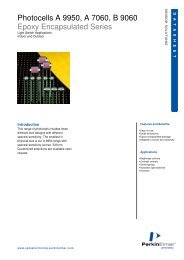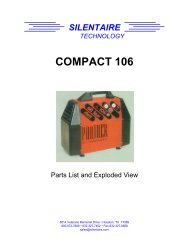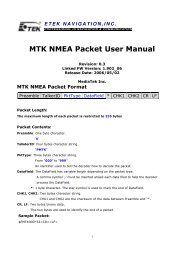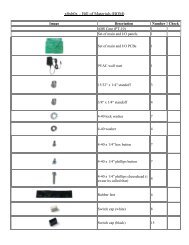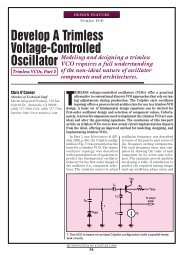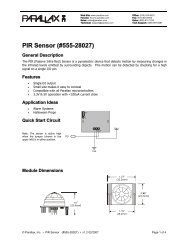Microstrip Patch Antennas for Broadband Indoor Wireless Systems ...
Microstrip Patch Antennas for Broadband Indoor Wireless Systems ...
Microstrip Patch Antennas for Broadband Indoor Wireless Systems ...
Create successful ePaper yourself
Turn your PDF publications into a flip-book with our unique Google optimized e-Paper software.
<strong>Patch</strong> length of 29.66 mm was determined using EXCEL spreadsheets [Refer to<br />
Appendix-B].<br />
5.3.3 Width<br />
The width is critical in terms of power efficiency, antenna impedance and<br />
bandwidth. It is largely dependent on the operating frequency and the substrate dielectric<br />
constant. The equation below was used to workout the width of the patch. Other widths<br />
could have been used but if it is too small then radiator efficiency will suffer and if it is<br />
too large higher order modes will be excited, resulting in field distortions [1, pg-57].<br />
C ⎛ ε r + 1⎞<br />
W = ⎜ ⎟<br />
(5)<br />
2 fr<br />
⎝ 2 ⎠<br />
The theoretical width was calculated to be 37.86 mm. Refer to Appendix-B <strong>for</strong><br />
the spreadsheet implementing Eq-5.<br />
5.3.4 Co-axial Probe Feed<br />
An advantage of this technique is that it can be placed at any location, and the<br />
impedance match will depend on its location on the patch. Using the equation provided in<br />
Bahl/Bhartia [1] we can approximate the feed coordinate, which would match the input<br />
impedance to a 50-Ohm feeder. An improved impedance match will ideally increase the<br />
bandwidth, the return loss and improve per<strong>for</strong>mance by reducing the excitation of<br />
unwanted modes of radiation. The feed co-ordinates were calculated using the following<br />
equation:<br />
Xf (along the length) =<br />
L<br />
2 ξ ( l)<br />
re<br />
The calculated feed coordinates <strong>for</strong> the given rectangular patch operating at 2.45<br />
GHz are Yf = 7.52 mm and Xf = 18.79 mm. But this equation is an approximation and<br />
will only provide the starting point. It is very much an iterative process, to workout the<br />
exact co-ordinates that will match the impedance of the feedline to the antenna. Using the<br />
Network analyzer, the following coordinates returned the best impedance match. AT Yf =<br />
7.00 mm and Xf = 20 mm, at an input impedance of 49.84–0.012j ohms. However it was<br />
found as the feed point was moved downwards from the calculated coordinates, the<br />
impedance match improved. But there was a threshold point beyond which, the match<br />
started to deteriorate.<br />
−1/<br />
2<br />
W<br />
Yf (along the width) =<br />
2<br />
ε<br />
r + 1 ε r −1<br />
⎛ h ⎞<br />
where ξ re (l)<br />
= + ⎜1+ 12 ⎟<br />
2 2 ⎝ L ⎠<br />
−1/<br />
2<br />
11<br />
(6)<br />
(7)




